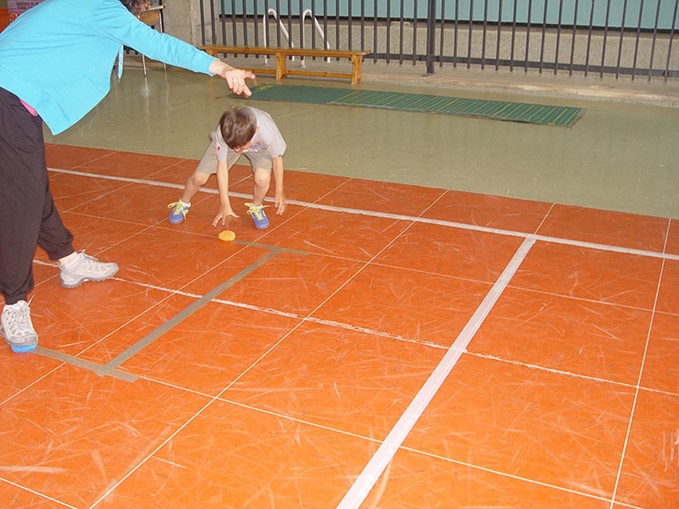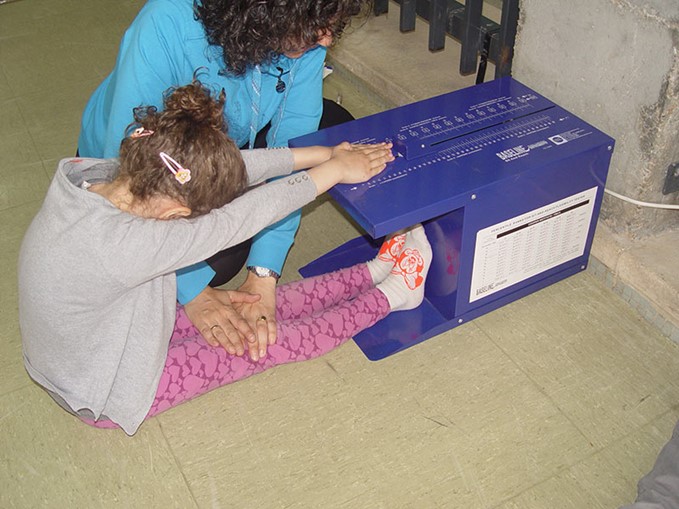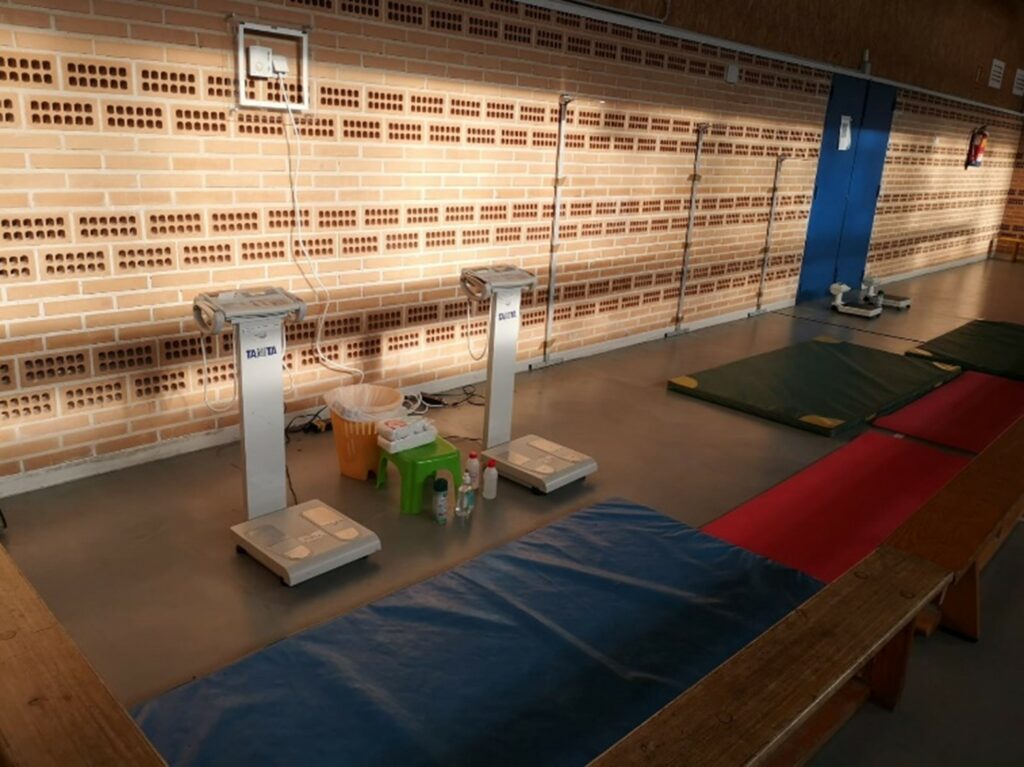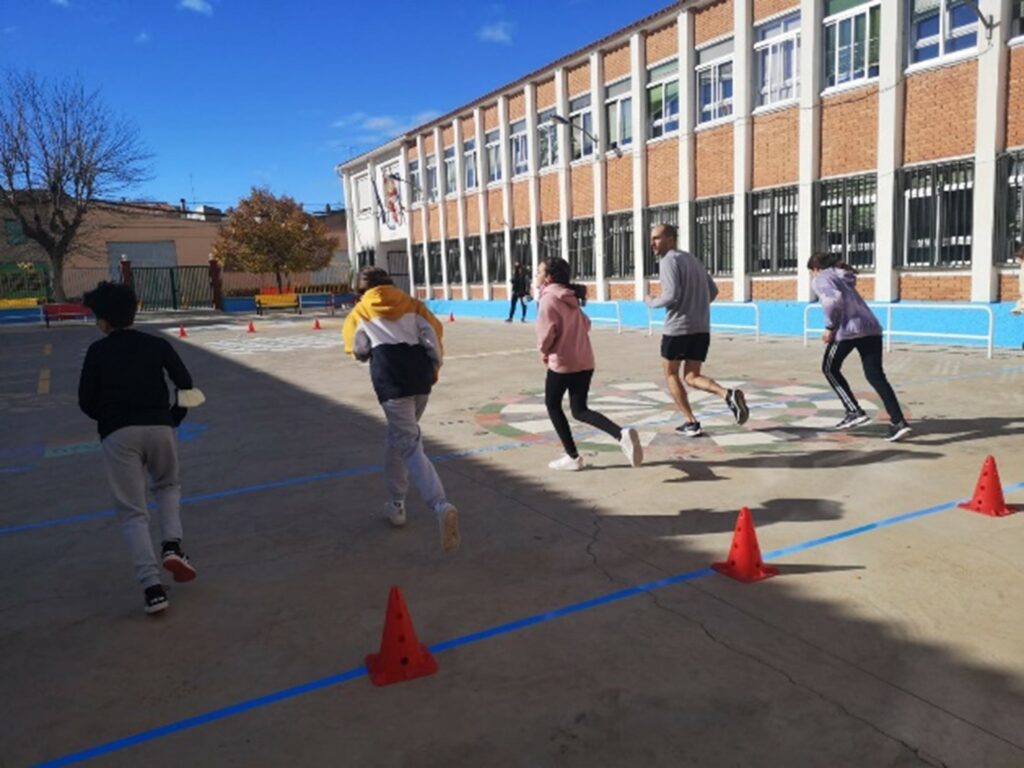

Movi-da 10!
and Movi-da FIT!
abstract
The objective of Movi-da 10! was to evaluate the effectiveness of two active break interventions (short periods of physical activity lasting 5-10 minutes conducted during class time) in the classroom to reduce adiposity and improve physical fitness and cognitive performance in children aged 4 to 6 years.
The objective of Movi-da 10! was to evaluate the effectiveness of two active break interventions (short periods of physical activity lasting 5-10 minutes conducted during class time) in the classroom to reduce adiposity and improve physical fitness and cognitive performance in children aged 4 to 6 years.
A three-arm group randomized controlled trial (two interventions and one control) was conducted with 314 children from 8 schools in rural and urban areas of the province of Cuenca. The schools were randomly assigned to one of the three groups: Movi-da 10-Enriched intervention (n = 3) with active breaks including curricular reinforcement, Movi-da 10-Standardized intervention (n = 2) with active breaks consisting solely of physical activity, and the control group (n = 3).
The target dose for both intervention groups was 100 minutes per week of additional physical activity (two 10-minute active breaks) during school hours throughout the academic year.


A three-arm group randomized controlled trial (two interventions and one control) was conducted with 314 children from 8 schools in rural and urban areas of the province of Cuenca. The schools were randomly assigned to one of the three groups: Movi-da 10-Enriched intervention (n = 3) with active breaks including curricular reinforcement, Movi-da 10-Standardized intervention (n = 2) with active breaks consisting solely of physical activity, and the control group (n = 3).
The target dose for both intervention groups was 100 minutes per week of additional physical activity (two 10-minute active breaks) during school hours throughout the academic year.

After one school year, the participants of Movi-da 10! showed improvements in cardiorespiratory capacity, lower body strength, and speed/agility compared to the schoolchildren in the control group.
After one school year, the participants of Movi-da 10! showed improvements in cardiorespiratory capacity, lower body strength, and speed/agility compared to the schoolchildren in the control group.
Movi-da FIT! analyzed the effectiveness of an extracurricular physical activity program based on high-intensity interval training (HIIT) to improve executive function, academic performance, physical fitness, and to reduce adiposity and cardiometabolic risk in primary school students.
Movi-da FIT! analyzed the effectiveness of an extracurricular physical activity program based on high-intensity interval training (HIIT) to improve executive function, academic performance, physical fitness, and to reduce adiposity and cardiometabolic risk in primary school students.

A randomized field trial was conducted, involving 10 schools. Five schools were assigned to the intervention group, and five to the control group. Movi-da FIT! consisted of 4 hours per week of extracurricular physical activity based on HIIT-adapted games throughout the school year.


A randomized field trial was conducted, involving 10 schools. Five schools were assigned to the intervention group, and five to the control group. Movi-da FIT! consisted of 4 hours per week of extracurricular physical activity based on HIIT-adapted games throughout the school year.
Participating Schools
CEIP Santa Teresa (Cuenca)
CEIP Adolfo Martínez Chicano (Las Pedroñeras)
CEIP Virgen de Manjavacas (Mota del Cuervo)
CEIP Valdemembra (Quintanar del Rey)
CEIP San Gil Abad (Motilla del Palancar)
CEIP Rafael López de Haro (San Clemente)
CEIP Gloria Fuertes (Tarancón)
CEIP María Jover (Iniesta)
CEIP Hermenegildo Moreno (Villanueva de la Jara)
CEIP Gúzquez (Villamayor de Santiago)
Funding



Funding



Status
Finished ✔
Articles
López-Gil JF, Cavero-Redondo I, Sánchez-López M, Pascual-Morena C, Lucerón-Lucas-Torres M, Martínez-Vizcaíno V. Is cardiorespiratory fitness a moderator of the relationship between sugar-sweetened beverage consumption and insulin resistance in schoolchildren? Eur J Nutr. 2023;62(1):213-220.
Martin-Espinosa N, Martínez-Vizcaíno V, Garrido-Miguel M, Díez-Fernández A, Isabel Cobo-Cuenca A, Solera-Martínez M. Decrease in the prevalence of hypertension in Spanish schoolchildren from 2010 to 2017: Cuenca Study. Eur J Cardiovasc Nurs. 2023;1;22(2):184-192.
Visier-Alfonso ME, Sánchez-López M, Álvarez-Bueno C, Ruiz-Hermosa A, Nieto-López M, Martínez-Vizcaíno V. Mediators between physical activity and academic achievement: A systematic review. Scand J Med Sci Sports. 2022;32(3):452-464.
doi: 10.1111/sms.14107
Martínez-Vizcaíno V, Soriano-Cano A, Garrido-Miguel M, Cavero-Redondo I, Medio EP, Madrid VM, Martínez-Hortelano JA, Berlanga-Macías C, Sánchez-López M. The effectiveness of a high-intensity interval games intervention in schoolchildren: A cluster-randomized trial. Scand J Med Sci Sports. 2022;32(4):765-781.
doi: 10.1111/sms.14113
Fernández-Sánchez A, Redondo-Tébar A, Sánchez-López M, Visier-Alfonso ME, Muñoz-Rodríguez JR, Martínez-Vizcaíno V. Sex differences on the relation among gross motor competence, cognition, and academic achievement in children. Scand J Psychol. 2022;63(5):504-512.
doi: 10.1111/sjop.12827
Berlanga-Macías C, Sánchez-López M, Solera-Martínez M, Díez-Fernández A, Ballesteros-Yáñez I, Castillo-Sarmiento CA, Martínez-Ortega IA, Martínez-Vizcaíno V. Relationship between exclusive breastfeeding and brain-derived neurotrophic factor in children. PLoS One. 2021;4;16(3):e0248023.
Reina-Gutiérrez S, Martínez-Vizcaíno V, Torres-Costoso A, Núñez de Arenas-Arroyo S, Saz-Lara A, Sánchez-López M. Maternal Education and Academic Achievement in Schoolchildren: The Role of Cardiorespiratory Fitness. J Pediatr. 2021;232:109-117.e1.
Martinez-Vizcaino V, Álvarez-Bueno C, Sanchez-Lopez M, Jimenez-Lopez E, Soriano-Cano A, Ortega FB, Cavero-Redondo I, Garrido-Miguel M. A Cluster Mediation Analysis Confirms the Validity of the “Fat but Fit” Paradigm in Children’s Cognitive Function and Academic Achievement. J Pediatr. 2021;231:231-238.e1.
Martínez-Vizcaíno V, Garrido-Miguel M, Redondo-Tébar A, Notario-Pacheco B, Rodríguez-Martín B, Sánchez-López M. The “Fat but Fit” Paradigm from a Children’s Health-Related Quality of Life Perspective. Child Obes. 2021;17(7):449-456.
G-Adalia E, Hernández-Luengo M, Martínez Andrés M, Bartolomé-Gutiérrez R, Rodríguez-Martín B, Jiménez-López E. Expectations and Experiences of Women in Pregnancy, Childbirth, and Infant Feeding: A Qualitative Research Protocol. International Journal of Qualitative Methods. 2021;20:1-8.
Nieto-López M, Sánchez-López M, Visier-Alfonso ME, Martínez-Vizcaíno V, Jiménez-López E, Álvarez-Bueno C. Relation between physical fitness and executive function variables in a preschool sample. Pediatr Res. 2020;88(4):623-628.
Garrido-Miguel M, Martínez-Vizcaíno V, Herráiz-Adillo Á, Martínez-Hortelano JA, Soriano-Cano A, Díez-Fernández A, Solera-Martínez M, Sánchez-López M. Obesity and thinness prevalence trends in Spanish schoolchildren: are they two convergent epidemics? Eur J Public Health. 2020;1;30(5):1019-1025.
Visier-Alfonso ME, Sánchez-López M, Martínez-Vizcaíno V, Jiménez-López E, Redondo-Tébar A, Nieto-López M. Executive functions mediate the relationship between cardiorespiratory fitness and academic achievement in Spanish schoolchildren aged 8 to 11 years. PLoS One. 2020;10;15(4):e0231246.
Martínez-Vizcaíno V, Álvarez-Bueno C, Cavero-Redondo I, Pozuelo-Carrascosa DP, Garrido-Miguel M, Martínez-Hortelano JA, Martínez-Madrid V, de Medio EP, Sánchez-López M; MOVI group. MOVI-daFIT! Intervention: Rationale and design of a cluster randomized controlled trial testing the effects on improving adiposity, cognition, and subclinical atherosclerosis by increasing cardiorespiratory fitness in children. Medicine (Baltimore). 2019;98(9):e14737.
Sánchez-López M, Ruiz-Hermosa A, Redondo-Tébar A, Visier-Alfonso ME, Jimenez-López E, Martínez-Andres M, Solera-Martínez M, Soriano-Cano A, Martínez-Vizcaíno V; MOVI group. Rationale and methods of the MOVI-da10! Study -a cluster-randomized controlled trial of the impact of classroom-based physical activity programs on children’s adiposity, cognition and motor competence. BMC Public Health. 2019;18;19(1):417.
Resources
Download the ebook with the description of the methodology and all the sessions of the Movi-da 10! program
Download the ebook with the description of the methodology and all the sessions of the Movi-da FIT! program

